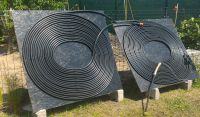I made myself a solar for heating the water in the pool. It consists of two OSB boards, painted black, and a fi20 100m hose.
To pump the water from the pool, to the solars and back to the pool, I used the dirty water pump which is located at the bottom of the pool. Its capacity is 9000l / min.
The problem is that it can't. After disconnecting one half of the hose (50m left) and turning on the pump, it spurts water. My conclusion is that I have too much hose installed.
Now the question: how to calculate how many snake can I leave?
For example, I connected a pump with a capacity of 11000l / min and it did not pump the water.
The pump is deaerated.

To pump the water from the pool, to the solars and back to the pool, I used the dirty water pump which is located at the bottom of the pool. Its capacity is 9000l / min.
The problem is that it can't. After disconnecting one half of the hose (50m left) and turning on the pump, it spurts water. My conclusion is that I have too much hose installed.
Now the question: how to calculate how many snake can I leave?
For example, I connected a pump with a capacity of 11000l / min and it did not pump the water.
The pump is deaerated.



